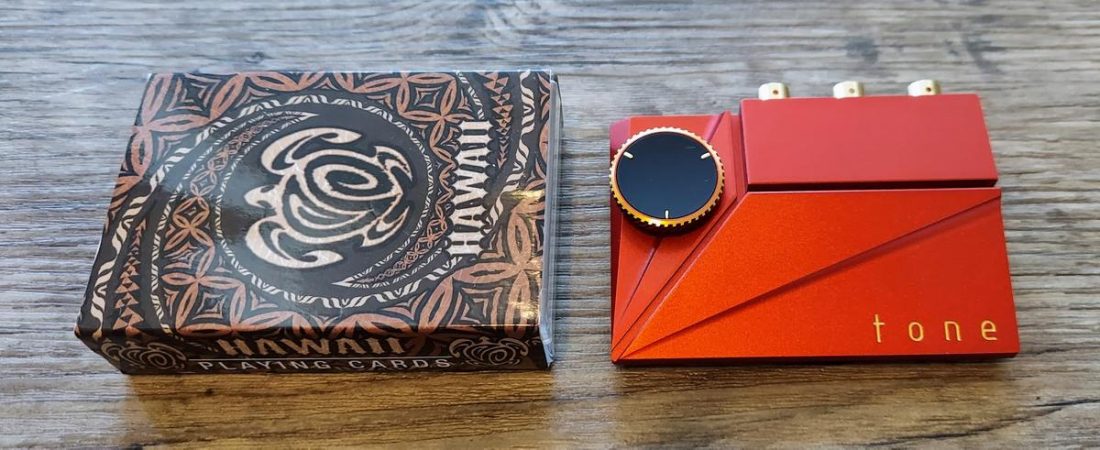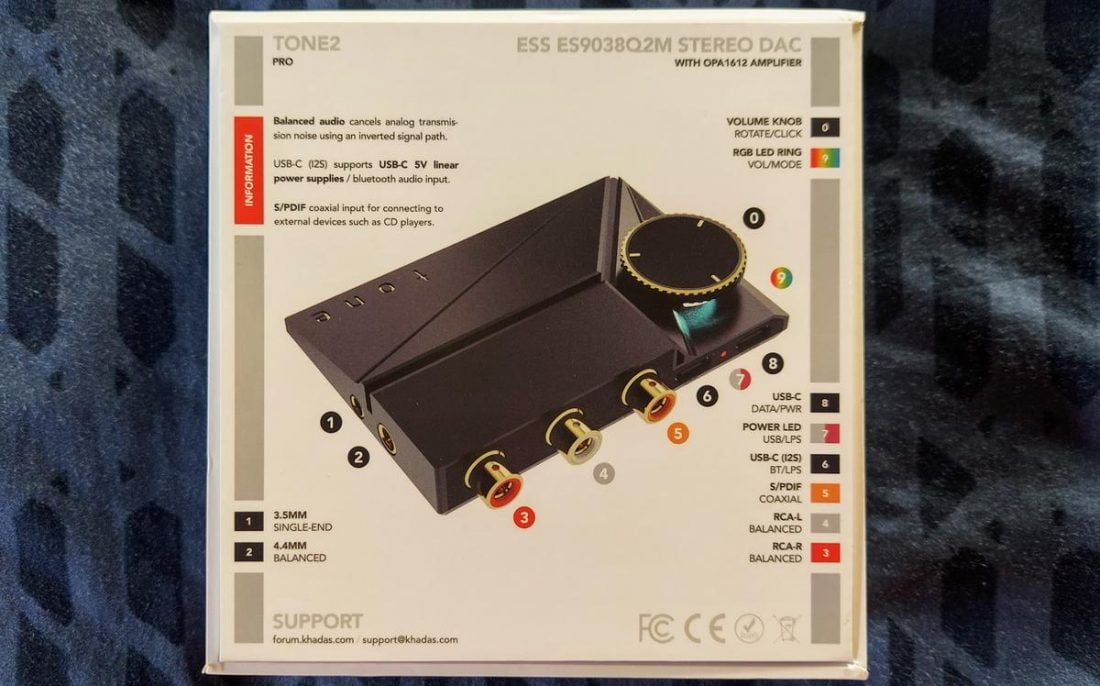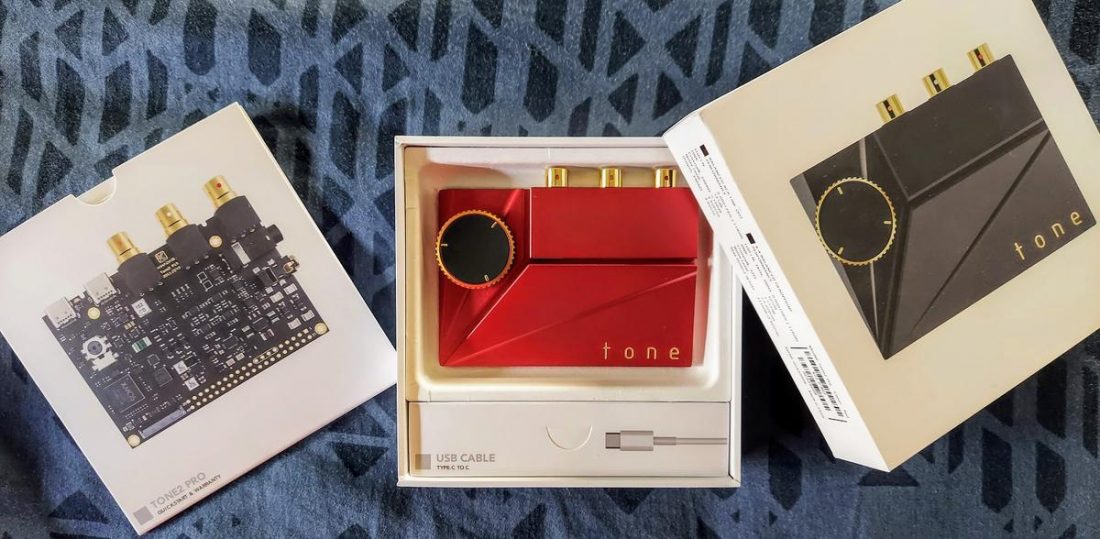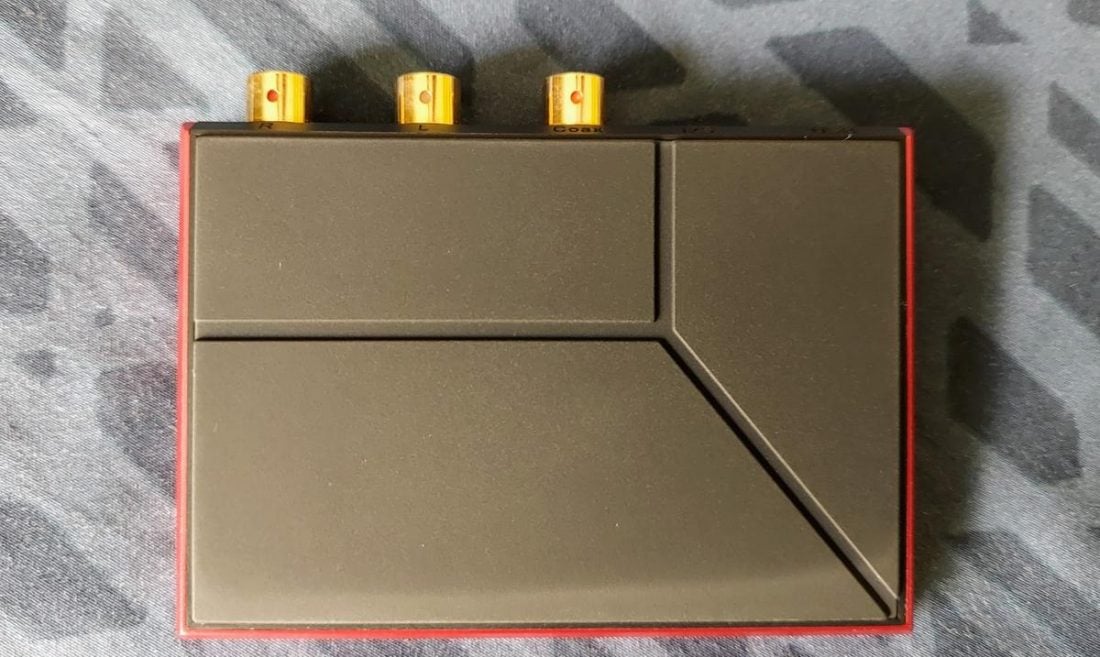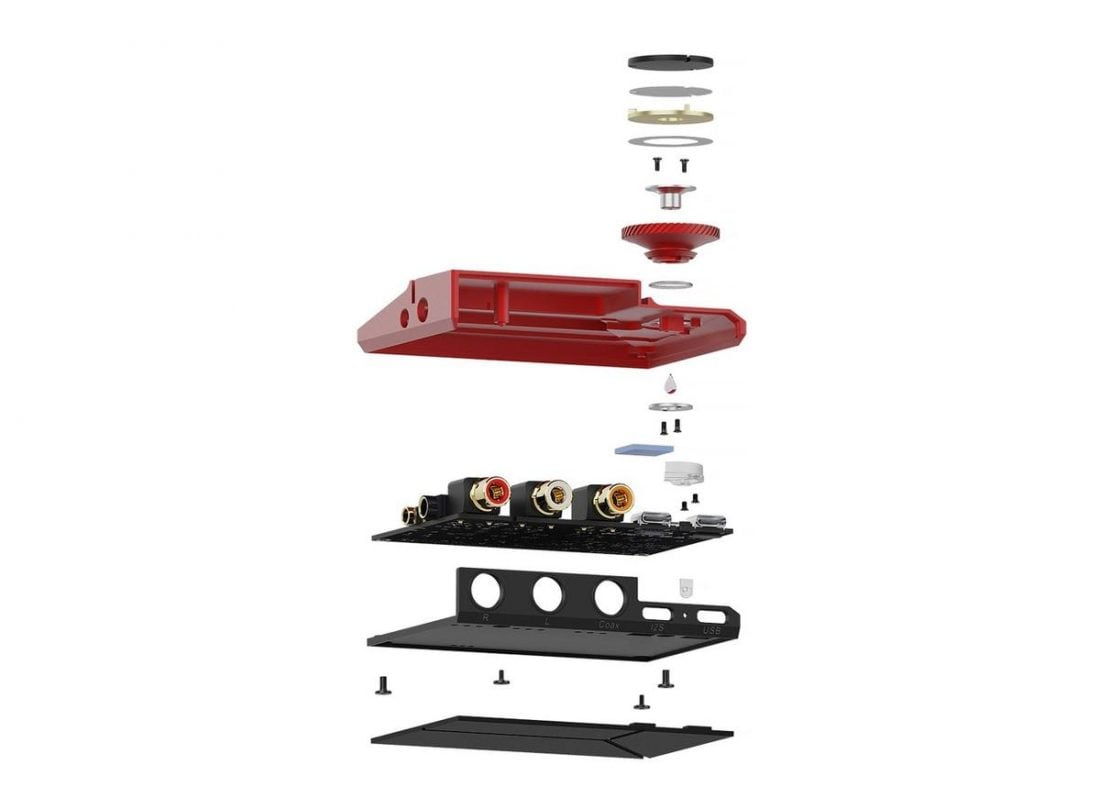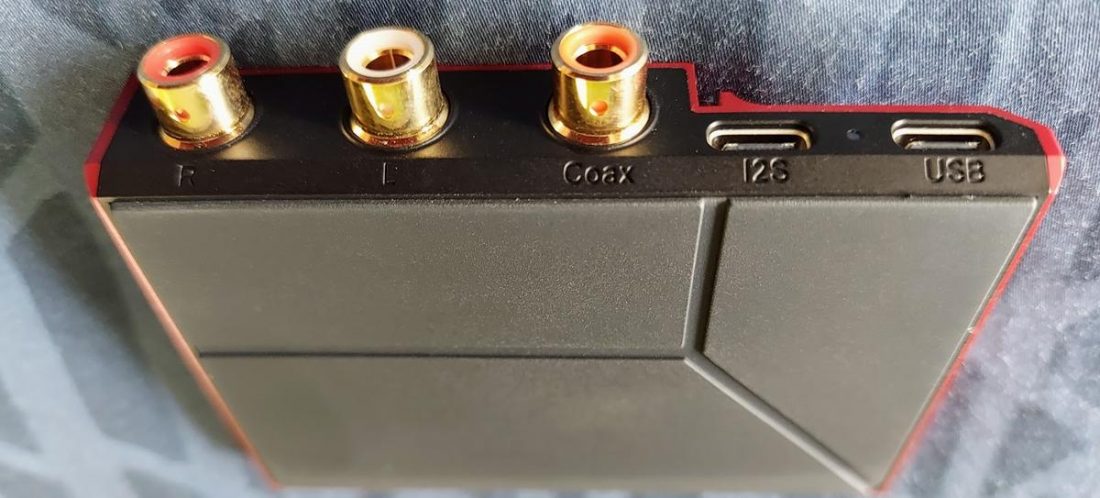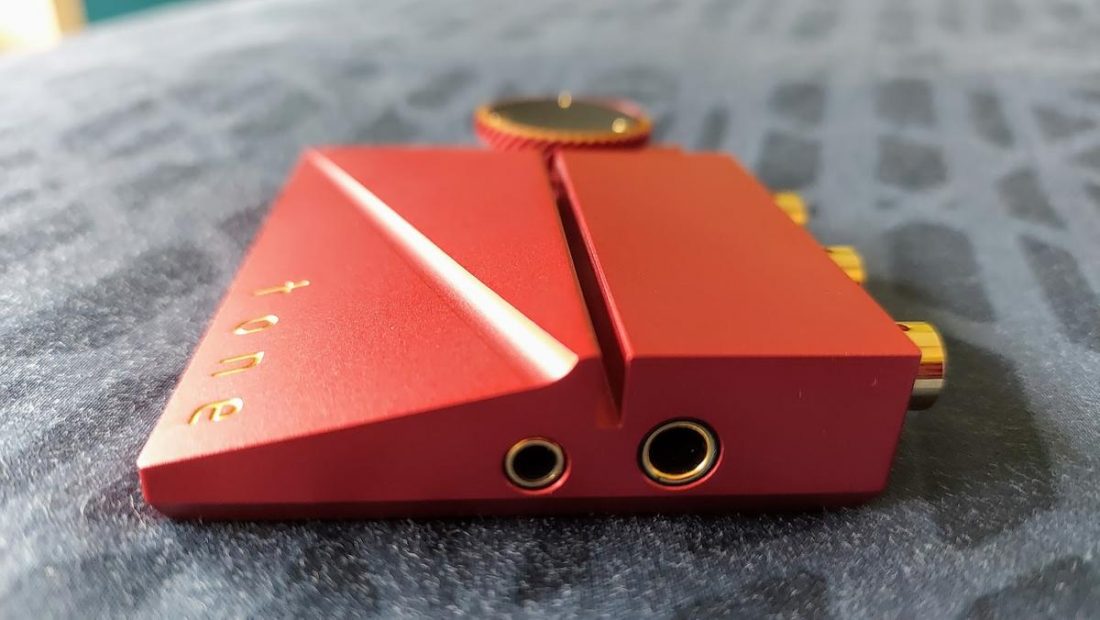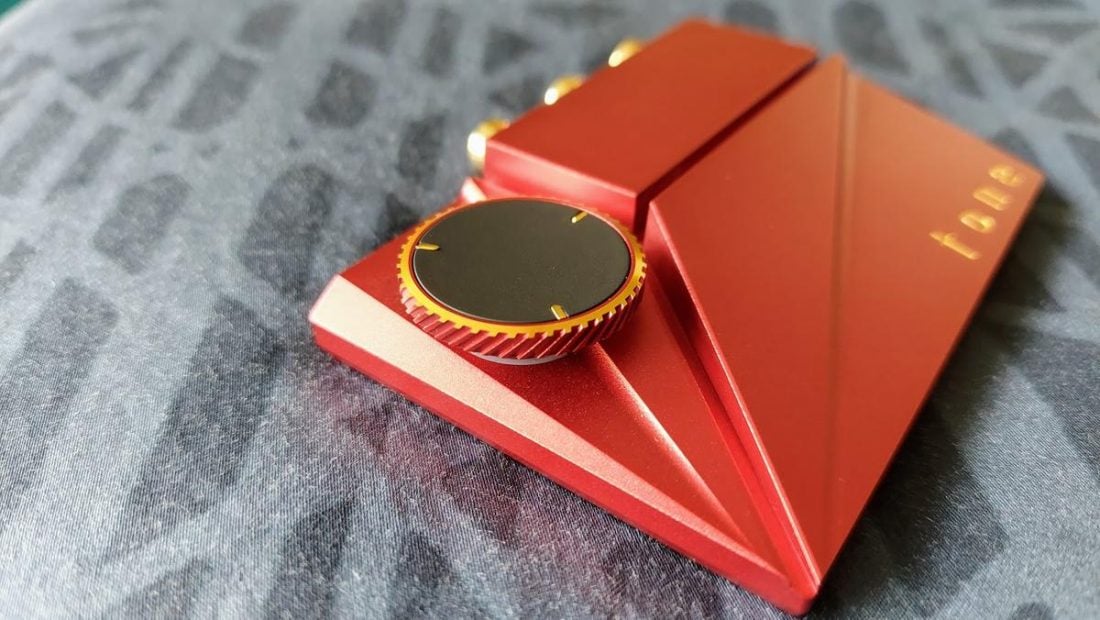The Tone2 Pro headphone Amp/DAC is Khadas’ second-generation Tone Board. It incorporates a variety of user feedback from their first-gen product, the Tone1, neatly packaged in an aircraft-grade aluminum enclosure – a first for Khadas.
First Impressions
Opening the box and uncovering the little and light Tone2 Pro, it feels remarkably solid and pleasingly substantial for something so small. There are no loose parts inside or outside, even when (probably inadvisably) shaking the device. The saturation of color in the metal housing is outstanding and is just as beautiful in person as it is in the photos. For something slightly smaller than a deck of cards, it has presence, exudes confidence, and calls your attention. Building my curiosity are several obvious physical elements, present and missing:
Present: a knurled aluminum rotating dial surrounded below by an RGB ring light (accurately, a hybrid digital/analog volume control knob, rotate/push encoder) on the face/top of the Tone2 Pro Present: two USB Type-C ports on the rear Present: what appear to be at first glance three RCA jacks on the back (accurately, two balanced RCA jacks (a Khadas standard and innovation, cables purchased separately), and a S/PDIF RCA jack for coaxial digital audio input) Missing: buttons, levers, and/or switches!
So how exactly does this device work? Instructions are most certainly required…
Company Overview
Khadas (Khadas Technology Co., Ltd.) focuses on developing, manufacturing, and marketing superior quality, high-performance Amlogic and Rockchip single-board computers (SBCs) for the open source community and streaming media player industry. Most recently, Khadas added audio products to their lineup, including the Tone2 Pro Hi-Fi DAC and Khadas balanced RCA connectors (more on this under Internals). Their parent company, Shenzhen Wesion Technology Co., Ltd. was founded in 2014.
Technical Specifications
Form: Desktop/portable headphone amplifier DAC Performance Input: Balanced RCA THD+N: 0.000126% (-118dB) THD+N, A-Weighted: 0.000112% (-119dB) Noise: 3.5uVrms Noise, A-Weighted: 2.75uVrms DNR: 121dB DNR, A-Weighted: 123.5dB Crosstalk, 200KΩ: > 120dB Output, 200KΩ: 4.0 Vrms Frequency Response, 20Hz~20KHz: ±0.15dB Input: Single-End RCA THD+N: 0.000158% (-116dB) THD+N, A-Weighted: 0.000141% (-117dB) Noise: 2.0uVrms Noise, A-Weighted: 1.6uVrms DNR: 119dB DNR, A-Weighted: 122dB Crosstalk, 100KΩ: > 118dB Output, 100KΩ: 2.0 Vrms Frequency Response, 20Hz~20KHz: ±0.15dB Headphone Amplifier Performance Output: 4.4mm Headphone Output Impedance: <0.3Ω THD+N, 1KHz, 300Ω: 0.000158% (-116dB) THD+N, 1KHz, 150Ω: 0.000158% (-116dB) THD+N, 1KHz, 32Ω: 0.000282% (-111dB) Noise: < 4.2uVrms DNR: 121dB Max Output @300Ω: 83mW (5.0Vrms) Max Output @150Ω: 167mW (5.0Vrms) Max Output @32Ω: 211mW (2.6Vrms) Crosstalk, 32Ω: > 117dB Frequency Response, 20Hz~20KHz: ±0.15dB Output: 3.5mm Headphone Output Impedance: <0.3Ω THD+N, 1KHz, 150Ω: 0.000200% (-114dB) THD+N, 1KHz, 32Ω: 0.000282% (-111dB) Noise: < 2.4uVrms DNR: 119dB Max Output @150Ω: 35.3mW (2.3Vrms) Max Output @32Ω: 125mW (2.0Vrms) Crosstalk, 32Ω: > 69dB Frequency Response: 20Hz~20KHz: ±0.15dB Sampling Rate USB Input: PCM 768KHz 32bit USB Input: DSD 512MHz 1bit (Native) Coaxial Input: 192KHz 24bit Processor: XMOS XU216, 16 Real-time Logical Cores DAC Chipset: ESS ES9038Q2M 32-Bit Stereo Mobile Audio DAC Amplifier Chipsets I/V Stage: TI OPA1612 x2 LPF Stage: TI OPA1612 x2 Buffer Stage: RT6863D x3 Ultralow Noise LDOs 1x ESS ES9311Q, 1.3uVrms (10Hz-100KHz) 5x ADI ADP151, 9uVrms (10Hz-100KHz) Jitter Filter Technology Built-in Intel Altera MAX V CPLD, Pre-shaping Technology Accusilicon AS318-B Series Professional Audiophile Crystal Oscillator O/S Compatibility: Windows 7, 8, 10 (Khadas USB ASIO driver required), MacOS, Linux (with UAC2 compliant kernel), Android (supports OTG function), iPadOS & iOS Rated Voltage: DC 5V Compliances: CE, FCC, RoHS Size: 17.0mm(h) x 88.0mm(w) x 61.5mm(l) / 68.0mm(with RCA) Weight: 100 grams
Packaging
The Tone2 Pro is housed in a small, tidy, well-constructed premium two-piece white box with a picture of the Tone2 Pro on the cover. Inside and under the top cover is a small document folder which serves to further protect the device, which itself is cradled by strong cardboard. Included is a second small box containing a USB Type-C to C cable (adapter not included).
In the box
Tone2 Pro USB Type-C to C cable Printed full-color instruction and information pamphlet One-year limited warranty card
Design
Realizing that every design aspect of the Tone2 Pro is both form and function is astounding given that this is Khadas’ first attempt at creating a housing for their DAC/Amp boards. The machining of the 6063 aluminium is impressive – solid and seamless with the body serving as a heatsink. The inside bottom is made of ABS and polycarbonate thermoplastics, covered with a silicone footpad to absorb external shocks, vibrations, and provides grip on smooth or slippery surfaces. GIven its small size and light weight, be mindful that it will easily move around with heavy cables or accidental tugs. The Tone2 Pro’s aluminum enclosure incorporates a hybrid digital/analog volume control dial, allowing you to rely entirely on analog signal attenuation for accurate sound reproduction. Technically, this feature incorporates an ALPS rotate-push encoder, allowing the user to control headphone volume and mode selection. The RGB ring-light displays real-time visual feedback. Here are some function examples as described (somewhat confusingly) by Khadas:
Rotation: Volume Control, Next, Previous Double-Push: Mode Selection (note: this really is more like a quick pull of the dial toward you if you have the Tone2 Pro in front of you) Long Push: Power ON / OFF (same note as above, it’s not actually a push)
The color and quantity of lights illuminated in the ring-light provide guidance on what functions and selections are available. They also translate an assortment of information and visual feedback. This is detailed in the instruction manual. The Tone2 Pro is available in your choice of black, red, or blue.
Internals
In addition to all of the impressive specifications listed above, Khadas claims that the 6-layer stack-up motherboard is a low dielectric PCB board for smoother audio. As previously noted, there are two USB-C ports. While either can both be used to power the Tone2 Pro, they can each perform a different function. The USB-C port labeled I2S is for a 5V linear power supply. The other, labeled USB, is for power and/or serves as a digital input for laptops or smartphones (to transmit data). The advantage of both is that the power supply can be separated from the signal, ensuring almost no interference between the two. This is for excellent power-noise isolation, resulting in an ultra-clean signal-to-noise ratio. The I2S USB-C port will support a future Khadas-designed external hi-res Bluetooth module compatible with premium Bluetooth codecs like aptX HD and LDAC (Qualcomm QCC5125). A silicone thermal conduction pad at the bottom of the Tone2 Pro moves heat away from the XMOS XU216 processor into the aluminum enclosure, ensuring that bit-perfect audio transmission is unaffected by thermal noise. The hybrid digital-to-analog volume knob is damped with a silicone O-ring and high-viscosity gel, resulting in a potentiometer-like feeling every time it’s used to change volume, input modes, etc. Upgradeable XMOS firmware ensures that your Tone2 Pro will be current for quite some time into the future with Khadas-provided updates/upgrades. To integrate balanced audio into a super compact desktop Hi-Fi DAC such as the Tone2 Pro, Khadas created and incorporated an industry-first: balanced RCA line-out. These novel RCA ports have three signal-pins instead of two (1 ground-pin and 2 signal-pins), enabling stereo audio transmission with just one connector. They retain the same size and form factor as regular RCA ports and are backwards compatible with standard RCA systems and cables. XLR-3 adapters are available as an accessory, ensuring seamless function with legacy balanced equipment. If you’d like to explore further about this innovation (great for tech-savvy enthusiasts!), visit the Khadas Balanced RCA page here.
Tone2 Pro Performance and Sound
The Tone2 Pro device itself is noiseless when powered on. Despite its prodigious power to weight ratio, it produces only enough heat to feel warm when used. It never seems to literally or figuratively break a sweat, thanks to the ingenious heat sink design. Regarding performance, I have three main priorities with DAC/Amps: I tested the Tone2 Pro with multiple sources via the USB and RCA inputs and a dozen headphones and IEMs. A critical test for me given the priorities above: plug in the headphones/IEMs and turn the volume up on the original source to maximum (with no signal playing), followed by increasing the volume on the amplifier. Listen for hiss or noise. The result every time: to my ears, ZERO audible noise. Even more amazing, this remains true with High Gain mode. Dark as a sealed lightless chamber. So much so, that I frequently find myself checking to see if the Tone2 Pro is plugged in and powered up. If it were not for the ring light and tiny LED indicator on the back next to the USB Type-C inputs, I would not know if it was on or not. Tone2 Pro combines the ESS ES9038Q2M with x4 OPA1612 operational amplifiers and three buffer amplifiers that deliver superior audio quality. The Tone2 Pro is optimally designed to drive relatively low impedance headphones (<300ohm suggested). The recommended maximum headphone impedance is 150ohms for the 3.5mm single-end jack, and 300ohm for the 4.4mm balanced jack. So can the Tone2 Pro drive headphones with higher impedance? The answer is yes, and most with no problem with likely the exception of the most power hungry headphones. It can be used solely as a DAC if you need to drive higher impedance headphones by connecting another headphone amplifier to the balanced RCA outputs. Regarding the sound, the Tone2 Pro seems to be transparent – I am unable to hear any notable ‘coloration’ of the sound in standard modes. I can attest to its clarity, meaning that the Tone2 Pro removes any signal noise and other artifacts, ensuring that the sound is reproduced accurately from its original source. If you are using the single-ended output via the 3.5mm jack, the maximum power for your headphones will be 8.8mW (output voltage = 2.3Vrms, power = 2.3×2.3/600=0.0088W). While this can work, the result may be lower/moderate volume output.
Filters
With the ESS ES9038Q2M 32-Bit Stereo Mobile Audio DAC chipset comes seven proprietary “Pre-Tuned Reconstruction” filters. Khadas’ user manual only explains how to access them via the selection dial. I cannot convincingly determine if they have any significant effect on the sound that a user will hear. Adding to my question, the seven filters are inconsistently and inaccurately labeled by Khadas. By referencing ESS directly, the accurate labels can be found (Khadas label : corresponding ESS label):
Linear fast : Linear-phase fast roll-off filter Most Common filter with clean overall suppression and excellent rejection, best for music with large transients. Provides crisp clean highs. Linear slow : Linear-phase slow roll-off filter Low group-delay and symmetrical inputs response. Less ringing then Linear-phase fast roll-off. Punchier bass than LPFR, with clean highs. Mini fast : Minimum-phase fast roll-off filter Minimal Pre-Ringing, preferred for Imaging and soundstage. No aliasing in frequency domain. Stronger bass than Linear Phase, clean highs. Mini slow : Minimum phase slow roll-off filter Non-Symmetrical filter designed to minimize pre-ringing. Strong punchy bass with good transient attacks. Apodizing : Apodizing fast roll-off filter type 1 (default) Version of Linear phase fast roll-off filter optimized to improve pre-ringing. Mini fast : Hybrid fast roll-off filter (note: this is a mistaken label by Khadas’ in their documentation and a repeat of the second filter type name) Combination of Linear-phase and Minimum-phase. Fast transient attack, strong punchy bass, crisp highs. Brick wall : Brick-wall One of the earliest designs, intended for highest suppression possible, with high delay and pre-ringing. Linear phase, crisp clean highs.
While they may technically work, I cannot verify that I hear any appreciable difference in the sound output in normal daily use. The Tone2 Pro is capable of up to 32bit 384KHz sample rate, bit-perfect DSD512 (playback hi-res DSD files from 64 to 512 Mbps rates), and -118dB THD+N (line-out). It is also one of the rare DAC/Amps to provide hardware MQA Decoding. The onboard XMOS XU216 processor enables bit-perfect “unfolding” of MQA data for both web streaming and local high fidelity audio playback. It will also decode 32-bit PCM at 768KHz.
Where to Buy
Conclusion
Advanced modern and next-generation technology. Serious bona fides. Meets and exceeds most users’ needs. Packing so much clean power into something so small is an incredible achievement. Those who will require more power will be a small population of users. If Khadas deems profitable, maybe another version is in its future. Even if larger, it would still be small. Regarding performance, there is little to critique and therefore little to improve upon. This is a new high bar for technology, capability, features, and performance in this price range. The paradoxical simplicity and complexity of the user interface and features are a different story. While these may not be to everyone’s liking, everyone is capable of learning and adjusting to the Tone2 Pro’s uniqueness. An app-based control panel will be a warmly welcome addition in the future, especially for users whose primary source is a computer or mobile phone. With this exceptional product, Khadas has thrown down the gauntlet. This Tone2 Pro receives an unequivocally high recommendation from me. It is my go-to DAC/Amp since taking up residence with my equipment.

